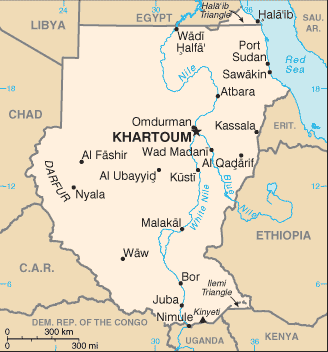Map:

Overview:
Military regimes favoring Islamic-oriented governments have dominated national politics since independence from the UK in 1956. Sudan has been embroiled in a civil war for all but 10 years since then. The war is rooted in northern economic, political, and social domination of non-Muslim, non-Arab southern Sudanese. Since 1983, the war and war- and famine-related effects have resulted in more than 2 million deaths and over 4 million people displaced. The ruling regime is a mixture of military elite and an Islamist party that came to power in a 1989 coup. Some northern opposition parties have made common cause with the southern rebels and entered the war as part of an anti-government alliance. Peace talks gained momentum in 2002-03 with the signing of several accords, including a cease-fire agreement.
The People:
Population: 40,187,486 (July 2005 est.)
Age structure:
0-14 years: 43.2% (male 8,865,331/female 8,488,982)
15-64 years: 54.5% (male 10,952,566/female 10,930,218)
65 years and over: 2.4% (male 513,679/female 436,710) (2005 est.)
Religions:
Sunni Muslim 70% (in north), indigenous beliefs 25%, Christian 5% (mostly in south and Khartoum)
Government Type:
authoritarian regime - ruling military junta took power in 1989; government is run by an alliance of the military and the National Congress Party (NCP), formerly the National Islamic Front (NIF), which espouses an Islamist platform
Leader(s) to pray for:
chief of state: President Field Marshall Umar Hassan Ahmad al-BASHIR (since 16 October 1993); First Vice President Salva KIIR (since 4 August 2005), Second Vice President Moses MACHAR (since 12 February 2001); note - the president is both the chief of state and head of government
Source: The World Factbook
View All Countries